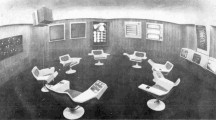Abstract
In 1972, in Chile, the German designer Gui Bonsiepe was in charge of the Industrial Design Department of Technological Institute of the National Corporation for the Promotion of Production INTEC Corfo, during the government of socialist President Salvador Allende in Chile. In this article from the INTEC magazine n.2, published this time for the first time in English, Bonsiepe develops a theoretical formulation, applied to the field of design, through which he proposes a concept that will be fundamental in the field of interactive development, both analog and digital: the Interface. Thus, it also includes concepts of cybernetics such as variability and predictive study of behavior in the field of projecting disciplines. Bonsiepe is an exceptional representative during the formation of the iconic Hochschule für Gestaltung in Ulm (HfG Ulm). And among other elements, one very outstanding was his time as a student of Professor Max Bense and Horst Rittel, who would have introduced the concepts of first-order Cybernetics in the teaching of communication, and the design of information, in a pioneering way (Leopold, 2014). The challenge posed in 1972, in Chile, focused on the possibility of calculating elements of criticism of political economy, in the field of knowledge generated by sensitive experiences, "calculating the use value" of the field of esthetics. As a renowned disciple of Max Bense and Tomas Maldonado, Bonsiepe represents the meeting of two Cybernetic traditions, collaborating with the emblematic Cybersyn Corfo project (Chile: 1970–1973), in which the formulation of interaction mechanisms was strategic in combination with Stafford Beer's approaches to a second-order Cybernetics, according to the Viable System Model (VSM), for a project of decentralized state production, and transmission of information in real time.














Similar content being viewed by others
Notes
Originally published in Spanish in the journal INTEC, the journal of the Comité de Investigaciones Tecnológicas de Chile/Corporación Nacional de Fomento a la Producción Corfo (Technological Institute of the National Corporation for the Promotion of Production), N° 2, in 1972, pp. 42–64, and in the journal AUCA in two parts, N° 24–25, pp. 7–12, in 1973; N° 26, pp. 7–10, in 1974.
In the context of this work we use design as a direct translation of the German term gestaltung, which encompasses design, planning, and configuration at the same time.
Points 1 and 2 were not published in the AUCA N° 24–25 original in 1973, apparently due to a printing error. Thanks to Ma. Alejandra Rojas, Head of Corfo Library for authorizing this reprint, as well as to the personal archive of Fernando Portal for the copy of Intec magazine N° 2, 1972, used in this translation.
Professor Stafford Beer, second-order cybernetics, main advisor of the Cybersyn project in Corfo in 1971–1973.
A few years after Jean Baudrillard published his book: Pour une critique de l'économie politique du signe, Gallimard, Paris, 1976.
The Andean Pact was created in 1969 with the Cartagena Agreement as a community of legal, political, cultural and economic cooperation. Originally composed of Bolivia, Colombia, Ecuador, Perú and Chile. In 1973 Venezuela joined the Andean Pact. In 1976, Augusto Pinochet announced Chile's withdrawal from the Andean Pact, citing economic incompatibilities.
Professor Horst Rittel, along with Professor Max Bense, introduced the ideas of Cybernetics at HfG Ulm.
The German concept of "gestalt" is quite linked to cybernetics, considering the analysis of the behavior of psychophysiological perception, but also its use in projecting. In Spanish it is usually translated as: "psychology of form", which reduces the understanding of its meaning.
Thanks to Gui Bonsiepe for this specification to translate the word "Proyectación" into English. November 11th, 2020.
References
Baudrillard J (1970) La societé de consommation. S.G.P.P, Paris, p 106
Beer S (1970) Operational research as revelation. Oper Res Q 21(1):9–21
Berlyne DE (1966) Structure and direction in thinking. Wiley, New York, p 300
Bitar S, Moyano E (1972) Redistribución del consumo y transición al socialismo. Cuadernos De La Realidad Nacional 11:22–44
Haug WF (1971) Kritik der Warenaesthetik (Crítica de la estética de la mercancía). Frankfurt, Suhrkamp, p 15
Kreipe W (1969) Spontaneltaet und Organisation. Kursbuch N 16:84
Luckman J (1967) An approach to the management of design. Oper Res Q 18:345–358
Marx K (1961) Das Kapital. H. J. Lieber, Stuttgart, pp 177–182
Newell A, Shaw C, Simon HA (1960) Report on a general problem-solving program. In: Prot. international conference on information processing. Paris, pp 256–254: UNESCO
Rapaport A (1969) Facts and models. In: Broadbent G, Wards A (eds) Design methods in architecture. Lund Humphres, London, pp 136–146
Reitman W (1966) Cognition and thought. Wiley, New York, p 126
Rittel H (1970) Der Planungsprozess als iterativer Vorgang van Varietaetserzeugung und Varietaetselnschraenkung. Entwurfsmethoden in der Bauplanung. Karl Kraemer, Stuttgart, pp 17–32
Simon HA (1969) The sciences of the artificial. MIT Press, Cambridge, p 59
Skinner B (1953) Science and human behavior. Macmillan, New York, p 246
Author information
Authors and Affiliations
Corresponding author
Additional information
Publisher's Note
Springer Nature remains neutral with regard to jurisdictional claims in published maps and institutional affiliations.
Rights and permissions
About this article
Cite this article
de los Reyes, D.M. Vi/vi/sec/tion of industrial design. Gui Bonsiepe and the formulation of the interface concept. Intec Chile 1972. Document of the beginning of a paradigm shift in the interaction design disciplines. AI & Soc 37, 1115–1129 (2022). https://doi.org/10.1007/s00146-021-01345-3
Received:
Accepted:
Published:
Issue Date:
DOI: https://doi.org/10.1007/s00146-021-01345-3




